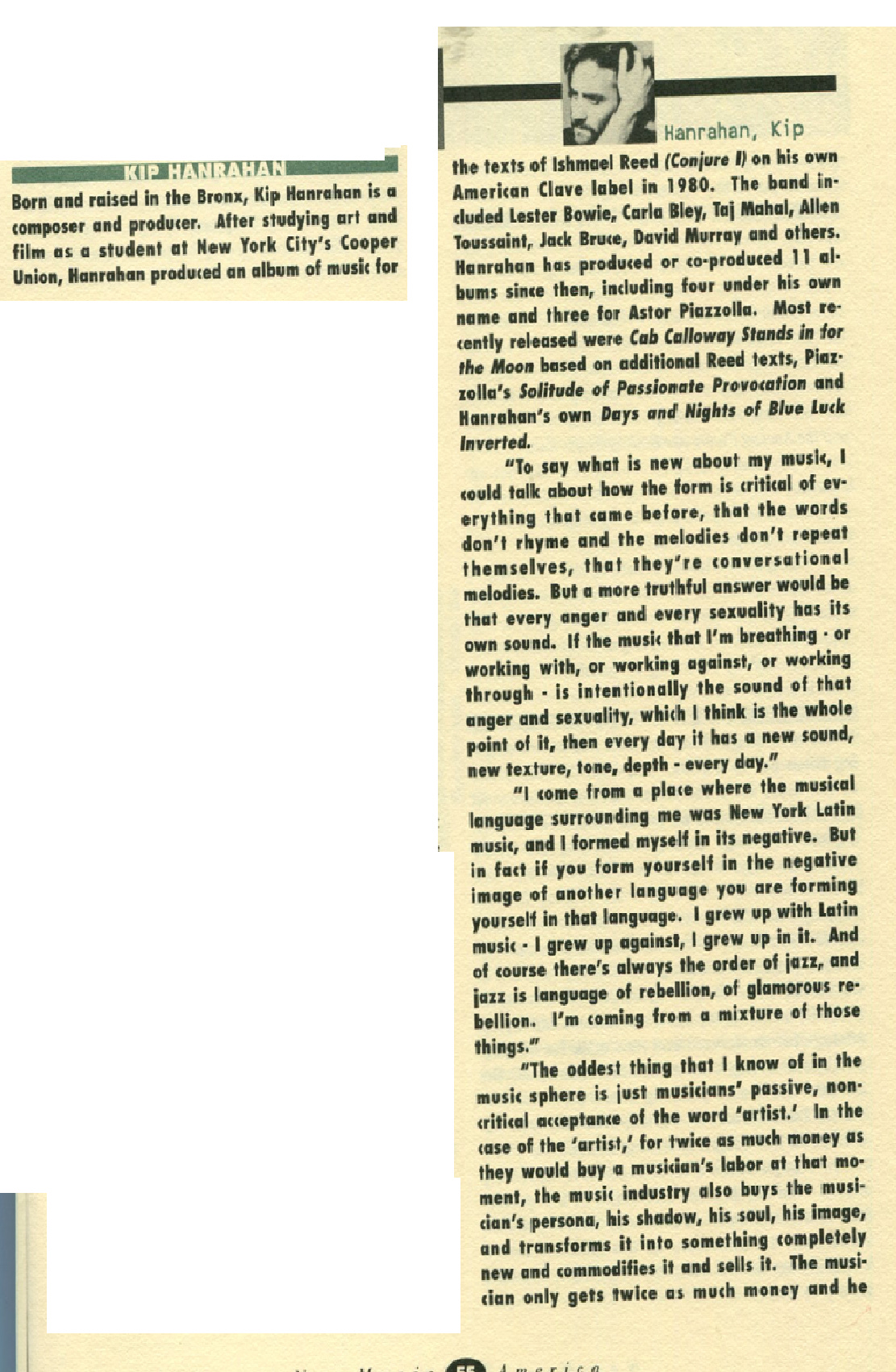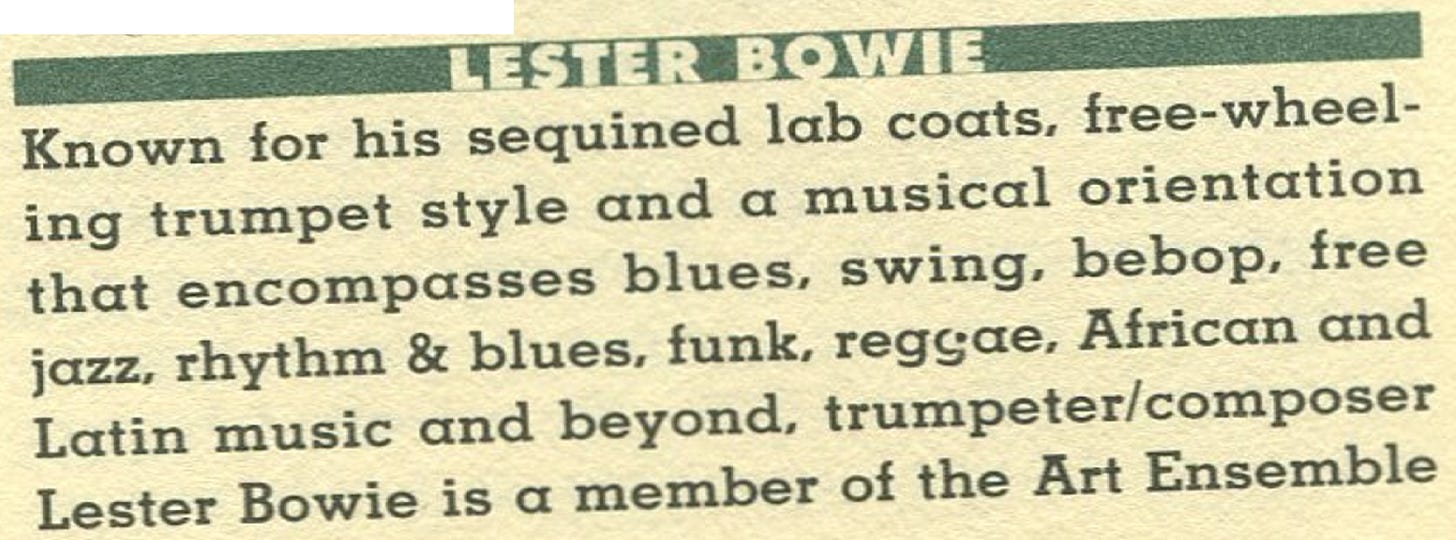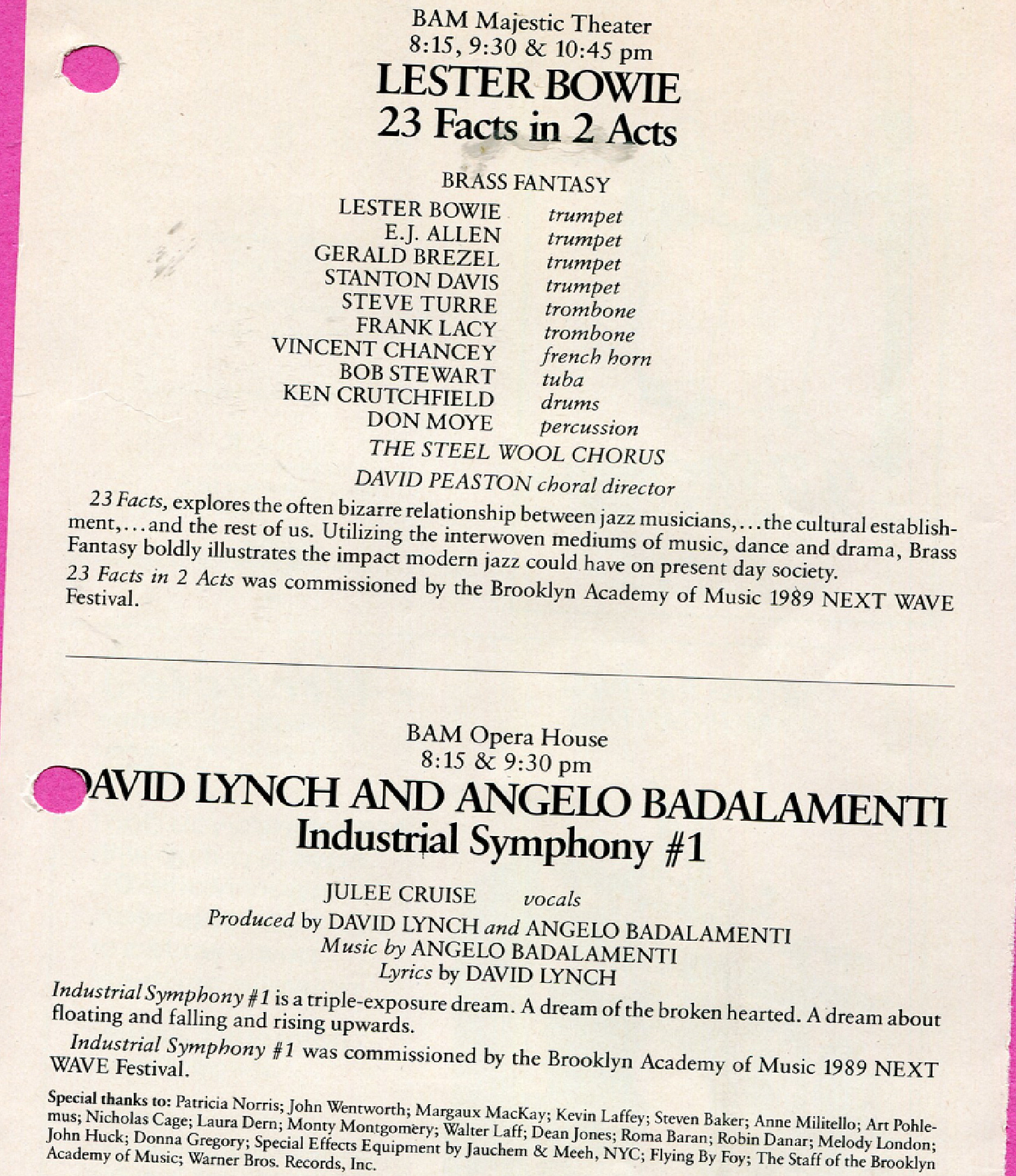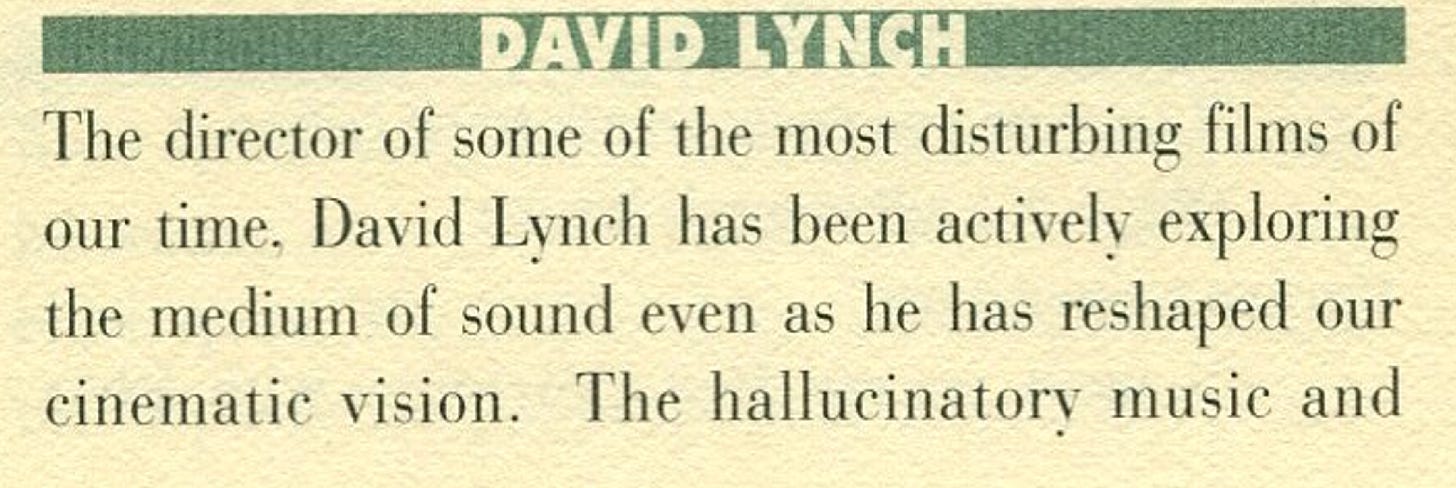November 10, 1989 New Music America New York City - Day 3 (first official day of concerts, though)
Kip Hanrahan ● David Lynch and Angelo Badalamenti ● Lester Bowie ● Miracle Room
Triple Bill at the Brooklyn Academy of Music
Kip Hanrahan Look, the Moon
David Lynch and Angelo Badalamenti with Julee Cruise Industrial Symphony No. 1
Lester Bowie 23 Facts in 23 Acts
Miracle Room at the Knitting Factory

After the Gala, the New Music America 1989 New York City festival got under way the same way it ended - with a three concerts repeated in three times at three venues at the Brooklyn Academy of Music complex presenting 45 minute works by Kip Hanrahan, David Lynch and Angelo Badalamenti and Lester Bowie.
We’re lucky to have a full concert video posted of (and maybe from a friend or a fan?) the Industrial Symphony No. 1, though I can’t tell you if this is the one of three that I attended, though I’m suspecting that it might be.
The big program book has too much stuff for me to feature all of them so I’ll be spreading them around on composer birthdays and in other places.
Kip Hanrahan Look, the Moon
This is the one for Kip Hanrahan:
…gives up that much control. I can't understand. That to me is the oddest thing."
1991 version:
*
NEW YORK - His musicians like his new work -- so composer Kip Hanrahan worries. Up close, the logic is impeccable.
"We were in the studio recording the basic tracks, and during the session the players kept saying 'This is the best thing you've ever done. This is great' -- and it really bothered me," said Hanrahan in a recent conversation. "When I say this, people laugh. They maybe think it's charming or that I'm being facetious, but, in fact, the musicians shouldn't have a handle on the concept yet. If they do, then it probably means it's not thorny enough." He pauses briefly, then continues. "Maybe I'm not moving far enough."
Hanrahan's "Look, the moon. . .," a song cycle commisioned by the Brooklyn Academy of Music for this year's New Music America festival, will be premiered at the Strand Theater, Saturday at 8 p.m. The concert, produced by the Jazz Coalition, is presented by the Strand Theater and the Institute of Contemporary Art.
How far Hanrahan is reaching might be hard to tell.
Throughout the 1980s, he created a one-man, streetwise avant-garde that defined its own borders and set its own pace.
He organized an unlikely repertory group that has included, among others, fabled '60s rocker Jack Bruce; the cream of the New York Latin players, including Chocolate Armenteros, Andy Gonzalez, Milton Cardona and Giovanni Hidalgo; jazz players such as David Murray and Steve Swallow; Ornette Coleman alumni Jamaaladeen Tacuma and Bern Nix; and downtown new wavers such as Bill Laswell, Anton Fier and Arto Lindsay.
…
Not a musician by training, Hanrahan played congas and guitar in a Latin dance band. "I don't think I was ever good. No, I know I was never good," he says. Not becoming a player has been "a real benefit." Often, as a player, he says, "you see and hear yourself through your hands. You don't hear sound. You don't hear context. You hear your playing, your labor, and that defines you. You don't think of yourself as someone who should try to take music somewhere else."
…
Not surprisingly, as a composer, bandleader and producer, he takes an approach that suggests a film director at work.
"Making a record is like making a film," he says with emphasis. "f anything, the analogy holds too true. The recording engineer becomes the cinematographer; I work with the musicians as I would with actors: You sing their lines the way they should be phrased; you shoot scenes, and the scenes are not in sequential order, and every scene has a different light and sound."
Rarely are all his musicians in the studio at the same time, rarely do they know how the finished piece is supposed to sound. He likens it to the Woody Allen approach to shooting. "It's like real life: You do your thing, you know your lines but never quite know how the other person is going to react or what happens afterwards." It's later, in the editing process, that Hanrahan brings the different elements together.
He speaks very fast, but halfway through an idea, his mind is racing on to the next thought and the thought after that. At times, he sounds as if he is impatient with having to put one word after another. His long sentences are full of knotty or humorous asides and references. He revises words just as he finishes saying them.
"This project started a year and a half ago and has changed many times since, " he says, "but there is a theme, a spine that still holds true." The original draft had a male and a female figure, in conflict with each other, and deities from the pantheon of Santeria, the Afro-Cuban religion. "The central characters would bargain with these deities for power positions against each other, and the deities would be both critical and interact with them."
The piece was first imagined as a music theater work, and poet Ishmael Reed and Cuban novelist Gabriel Cabrera Infante were to contribute to the text. "I actually wrote the whole thing," he says. "Then financing started pinching in." He changed the structure into a song cycle. "I'm trying to rein in expectations," he says.
He's been writing and rewriting for the last several weeks. "I'll probably be working till the afternoon of the concert," he says. After all the changes, many of them still to happen, "the center of gravity, the thing from which everything spins out, is the male-female sexual tension and anger. I don't want this music to be a reflection or a representation or an articulation of this tension but its sound. Of course, it can never be. But the attempt is this piece. "
- Fernando Gonzalez, “Kip Hanrahan’s Background: Everything But Music”, Boston Globe, October 29, 1989
♪
The 1990 recorded version has both Carmen Lundy and Diahnne Abbott:
♪
Lester Bowie 23 Facts in 23 Acts
This was the album released by the Brass Fantasy in 1989:
Brass Fantasy in concert seven months later in July, 1991
David Lynch and Angelo Badalamenti with Julee Cruise Industrial Symphony No. 1
*
Newsday review:
♪
At the Knitting Factory:
*
Newsday review:
The trio released a four track album in February 1990:

















